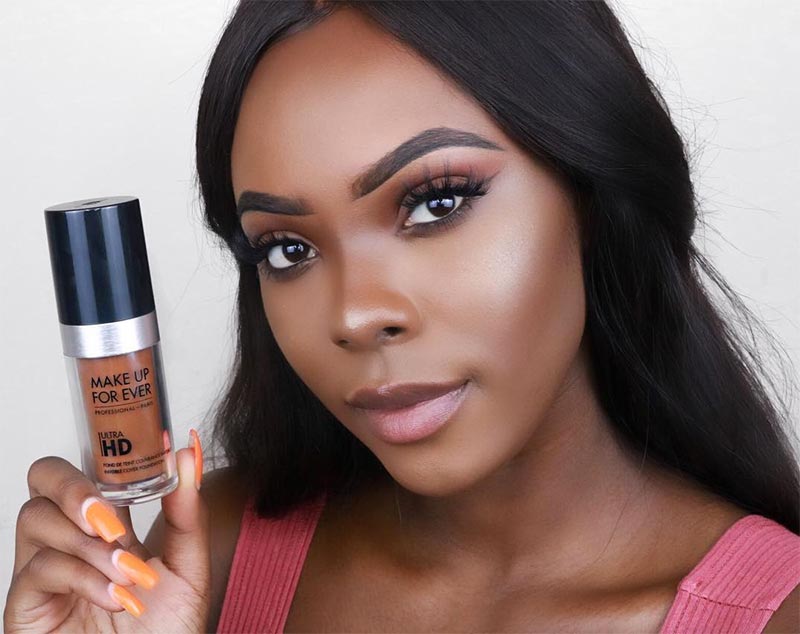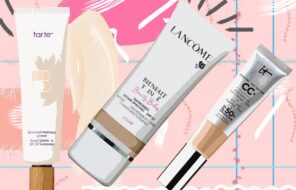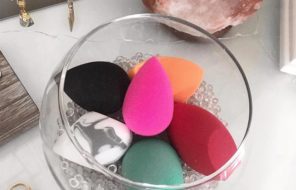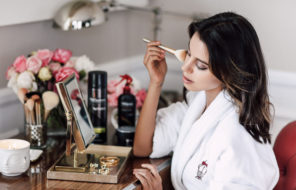Choosing the right foundation for dark skin can be a source of immeasurable frustration for people more richly endowed with melanin. Honestly finding makeup for dark skin can always be difficult, but foundations for dark skin are especially problematic.
Most people have at least two different shades of foundation, depending on the color of their skin in the summer and in the winter, and many with darker skin tones have to custom-blend their own. Makeup for dark skin doesn’t have to be a hassle to find, once you have the knowledge you need. It gets easier!
Choosing your foundation is really about making sure all the features of your skin are appropriately addressed. To do this you have to learn about your skin, but once you know how to get the information you need and what to do with it, you’ll have a much easier time finding a foundation for dark skin in the future, even if your skin changes.
Finding the right foundation is a matter of matching your undertone, the shade of your skin, addressing your texture and getting the right amount of coverage for your individual needs. So, what do you need to know? Let’s start with your undertone, overtone, and skin type.
Foundation should smooth out your skin tone, not change it. Your skin should appear relaxed and refreshed, never cakey, ashy or discolored. Foundations that are built on undertones of warm, neutral and cool are best to shop through, as they will provide a better match. Brands that work with a single beige tone and ‘add pigment’ to make a flat darker color will mask the natural glow in a darker skin tone.
Foundation is as important as the name implies, but the lack of diversity in most mega brands means that many of us with darker-toned skin are left with substandard options when compared to lighter-skinned counterparts.
In this article:
- Determine Your Skin Tones
- Testing for the Right Shade
- Longevity of Your Perfect Foundation
- Finding the Perfect Foundation for Dark Skin Based on Skin Types
- Foundation Formula Preferences
- Foundation Color Names
Determine Your Skin Tones
The wrong undertone can make you look like someone forgot to adjust their television – but only on your face. Too light and you look ashy. Too dark a foundation for your skin is just as obvious. The best way to choose a foundation is to learn about your skin and how to choose the right foundation for your darker skin tone.
There are both undertones and overtones in your skin. The undertone of your skin never changes, so it is monumentally important to pay attention to it when choosing your foundation.
Your skin’s overtone is likely the most obvious combination between your face and chest. There are three major undertones, so thankfully the process for finding yours will not be too complicated.
The three different undertones are Cool, Warm and Neutral. There is no hard and fast rule as to which darker skin shades will have what undertone, it is all dependent upon the person.
One of the easiest ways to determine your undertone is to inspect the veins on the underside of your wrists under natural light. You can do the white vs off-white test using clothes from your closet. Just hold up a piece of clothing in white and another in off-white near your (makeup-free) face. Which shade looks better against your skin?
The same can be done with silver and gold jewelry to determine your skin undertone.
- Cool undertones are typically indicated by blue or purple tinted veins. Cool undertones also typically look luminous against silver jewelry. Additionally, white clothes look complimentary next to skin with cool undertones. Cool undertones are considered pink, red and blue.
- Warm undertones are typically indicated by bluish green tinted veins. Warm undertones appear to glow vibrantly when wearing gold jewelry. Warmer undertones look best against off-white rather than white fabric. Warm undertones are yellow or golden.
- Neutral undertones are typically indicated by the presence of both bluish green and purplish tinted veins, though sometimes it is difficult to tell. When it comes to jewelry both gold and silver look similarly good against your skin. Both crisp white and off-white look great against skin with neutral undertones. Neutral undertones are a mixture or blend of each.
With overtones, you can range from lightly browned to warm rich deep brown tones. When you glance through the options in the little bottles, jars and tubes with your eyes, you are generally looking for the obvious match to your overtone.
Testing for the Right Shade
After finding your undertone, choose a few options that could work on your skin. The recommended number of foundation shades to pick is three that are close in color to each other.
The next step is to test the foundation to make certain it matches your dark skin overall. Avoid testing your potential foundations on your hand, as darker skin tends to be a different color on the back of your hand than on your face.
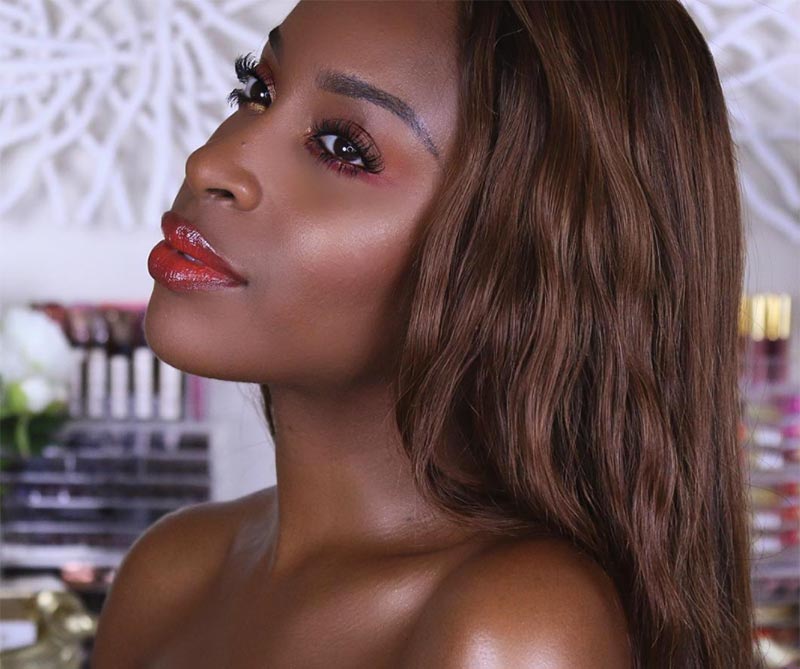
The recommended place to test a foundation by many makeup artists (MUAs) is the jaw line. Just swatch the colors next to each other on the jawline. Others say to test on the upper part of your chest. Choose whichever you feel gives you the most accurate results, as this can vary on an individual basis.
If you have chosen well, you should have one that is slightly darker, one that is slightly lighter and similar to the story of Goldilocks, one that is just right. Choose the one that is the closest match of course, but note the other two shades, as they may be the ones you need in the opposite season (winter or summer), if you find that your standard shade is no longer a match.
If none of the shades are perfect, then there are two options – check out another brand or choose the two closes and blend a custom color. If you choose to check out another brand, just repeat the same steps until your find the perfect shade.
If you are going to create a custom color of foundation for your dark skin, you’re going to have to test at home to find the perfect blend. This is more ideal if you have the time and interest as the changing of the seasons will not catch you unprepared, you can just blend what you need.
Don’t be wary of testing, it’s the best way to find your best match. Try your best to do your testing in, near or under natural light. I know this is difficult in department stores and at most makeup counters, but when and if possible, do. Natural light will give you the best view of your undertone and your overtone together, and allow you to see the coverage and color of the foundation as well.
Longevity of Your Perfect Foundation
Long-wear is one of the big features people look for in any foundation. Some people have very long workdays and no time to reapply. The best way to gauge the longevity of wear offered by a foundation is reviews – not ads.
Sure, the inclusion of a new feature that claims to create a smooth finish that lasts hours upon hours is intriguing, but real-life application and wear are best. Unsurprisingly, foundations that are mattifying and oil-absorbing tend to last longer.
Finding the Perfect Foundation for Dark Skin Based on Skin Types
Oily skin, combination skin, normal skin and dry skin, acne-prone and sensitive skin are all skin types that many cosmetic companies are providing specially formulated foundations for. You can have a combination of more than one skin type, so knowing yours can help you with more than just choosing your foundation for dark skin.
You can choose a facial cleanser, moisturizer and, of course, your foundation better if you’re informed. Since knowing your skin type is essential to choosing the right foundation for your skin type, here is the easiest way to find out your skin type if you don’t know it already or are not sure.
- Wash your face thoroughly but not excessively. Make certain all makeup, oil and dirt are removed using gentle cleanser in massaging motions. Rinse your face with room temperature water. Over-washing or scrubbing your face too hard can skew your results by drying out your skin. Pat your face lightly to dry it.
- Wait an hour or two, just relax. Do not apply anything to your skin at this point. No moisturizer or prescription treatments, apply nothing to your face.
- Examine your skin to figure out your skin type.

Dry Skin
- A tight feeling means you have dry skin.
- When checking your pores, take a few steps away from the mirror. If you cannot still see your pores, you have dry skin.
- Dabbing your face with a tissue will produce nothing on the tissue if you have dry skin.
- Pinching dry skin will make it feel like you have wrinkles.
- Dry skin can look drier with mattifying foundations, so go for those with a creamy consistency designed to give a ‘dewy’ appearance instead.
Oily Skin
- Oily skin will just feel cleaner after washing, no tight feeling at all.
- Oily skin typically has visible pores, even after taking a step or two back from the mirror.
- Dabbing your face with a tissue and finding oil on it means that you have oily skin.
- Oily skin will still feel smooth if you pinch it.
- Most darker skin types have a tendency to also be oily, so do not be surprised if you fall into this category.
- Oily skin looks best with mattifying and oil-absorbing foundations.
Combination Skin
- Identifiers for combination skin will be a clean-feeling T zone but tight cheeks and possibly chin area.
- Combination skin will show more than one standard pore size on the face.
- Dabbing with tissue, especially across the T zone will likely only show oil on the tissue if you have combination skin.
- When shopping for foundation, decide which finish looks best, satin, dewy or velvety matte, and then choose the correct shade based on your under- and overtones.
Sensitive and Acne-Prone Skin
Sensitive skin and acne-prone skin will be easily apparent, but if you are not sure, the absolute best option you have is to visit a dermatologist. If you are prone to breakouts of acne, then you are likely acne-prone, and if your skin is easily irritated, you likely have sensitive skin.
There are options to deal with these, but it will never be less pertinent that you see a dermatologist in case you need a recommendation for a product that can greatly ease your discomfort. Additionally, certain foundations can contain acne-fighting ingredients that are great for those with acne-prone skin.
Foundation Formula Preferences
Powders, liquids, cream and stick foundations for dark skin all exist so you can choose the option that is best for you. All of these can look cakey if you do not apply them correctly, but there are pros and cons to each.
For people with fine lines, powders can sit in them, making them more obvious if you are not careful with your application. If you are heavy handed, choosing a lightweight liquid foundation that spreads and blends smoothly and easily can be a great option.
Your preferences can also tie into how you choose to apply your foundation, which we will cover later as well. Everything plays a role, but so choose your options for your face and your needs, not based on trends.
Foundation Color Names
If you don’t end up being a ‘brand loyal’ person, there is another obstacle that you’ll face: color names of foundations for dark skin. Colors like Deep Honey, Warm Pecan, Golden Brown, Mocha and Café au Lait will not always match across brands.
It is imperative to test foundations when trying out new brands, do not rely on the names. One of the benefits for companies that use codes, like MAC Cosmetics, is that the names are typically grouped.
The codes break down so NC20, for example, would be NC (Neutral Cool) and shade 20. These color codes use the six-shade color wheel for undertones. The breakdown is below:
- C: Cool
- NC: Neutral Cool
- N: Neutral
- NW: Neutral Warm
- W: Warm
Photos via @princess.kaae_, Instagram

